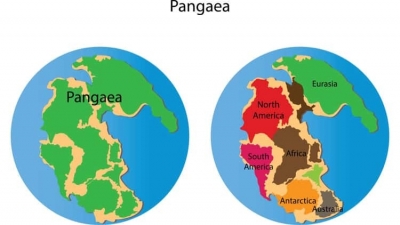
Gondwana was an ancient supercontinent that broke up about 180 million years ago. The continent eventually split into landmasses we recognize today: Africa, South America, Australia, Antarctica, the Indian subcontinent and the Arabian Peninsula.
According to plate tectonic evidence, Gondwana was assembled by continental collisions in the Late Precambrian (about 1 billion to 542 million years ago). Gondwana then collided with North America, Europe, and Siberia to form the supercontinent of Pangea. The breakup of Gondwana occurred in stages. Some 180 million years ago, in the Jurassic Period, the western half of Gondwana (Africa and South America) separated from the eastern half (Madagascar, India, Australia, and Antarctica). The South Atlantic Ocean opened about 140 million years ago as Africa separated from South America. At about the same time, India, which was still attached to Madagascar, separated from Antarctica and Australia, opening the central Indian Ocean. During the Late Cretaceous Period, India broke away from Madagascar, and Australia slowly rifted away from Antarctica. India eventually collided with Eurasia some 50 million years ago, forming the Himalayan Mountains, while the northward-moving Australian plate had just begun its collision along the southern margin of Southeast Asia.
Credit: Britannica
Picture Credit : Google




